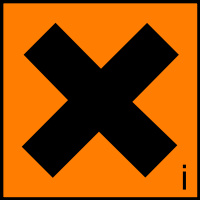|
Storage Condition
|
|
2-8°C, Desiccate
|
 Show
data source Show
data source
|
|
Refrigerator
|
 Show
data source Show
data source
|
|
|
Storage Warning
|
|
Air Sensitive
|
 Show
data source Show
data source
|
|
Highly Flammable/Irritant/Light Sensitive/Air Sensitive/Keep Cold/Store under Argon
|
 Show
data source Show
data source
|
|
|
European Hazard Symbols
|
 Flammable (F) Flammable (F)
|
 Show
data source Show
data source
|
 Irritant (Xi) Irritant (Xi)
|
 Show
data source Show
data source
|
|
|
UN Number
|
|
1989
|
 Show
data source Show
data source
|
|
UN1989
|
 Show
data source Show
data source
|
|
UN1993
|
 Show
data source Show
data source
|
|
|
MSDS Link
|
|
|
German water hazard class
|
|
3
|
 Show
data source Show
data source
|
|
|
Hazard Class
|
|
3
|
 Show
data source Show
data source
|
|
|
Packing Group
|
|
2
|
 Show
data source Show
data source
|
|
II
|
 Show
data source Show
data source
|
|
III
|
 Show
data source Show
data source
|
|
|
Australian Hazchem
|
|
3YE
|
 Show
data source Show
data source
|
|
|
Risk Statements
|
|
11
|
 Show
data source Show
data source
|
|
11-36/37
|
 Show
data source Show
data source
|
|
11-37/38
|
 Show
data source Show
data source
|
|
R:11
|
 Show
data source Show
data source
|
|
|
Safety Statements
|
|
16-23
|
 Show
data source Show
data source
|
|
9-16-26-46
|
 Show
data source Show
data source
|
|
9-16-33
|
 Show
data source Show
data source
|
|
S:9-16-29
|
 Show
data source Show
data source
|
|
|
EU Classification
|
|
F1
|
 Show
data source Show
data source
|
|
|
EU Hazard Identification Number
|
|
3B
|
 Show
data source Show
data source
|
|
|
Emergency Response Guidebook(ERG) Number
|
|
129
|
 Show
data source Show
data source
|
|
|
TSCA Listed
|
|
是
|
 Show
data source Show
data source
|
|
|
GHS Pictograms
|

|
 Show
data source Show
data source
|

|
 Show
data source Show
data source
|
|
|
GHS Signal Word
|
|
Danger
|
 Show
data source Show
data source
|
|
|
GHS Hazard statements
|
|
H225
|
 Show
data source Show
data source
|
|
H225-H315-H335
|
 Show
data source Show
data source
|
|
H225-H319-H335
|
 Show
data source Show
data source
|
|
|
GHS Precautionary statements
|
|
P210-P243-P403
|
 Show
data source Show
data source
|
|
P210-P261
|
 Show
data source Show
data source
|
|
P210-P301+P310-P305+P351+P338-P403+P233
|
 Show
data source Show
data source
|
|
|
Personal Protective Equipment
|
|
Eyeshields, Faceshields, full-face respirator (US), Gloves, multi-purpose combination respirator cartridge (US), type ABEK (EN14387) respirator filter
|
 Show
data source Show
data source
|
|
|
RID/ADR
|
|
UN 1989 3/PG 2
|
 Show
data source Show
data source
|
|
|
Storage Temperature
|
|
2-8°C
|
 Show
data source Show
data source
|
|